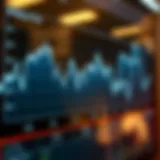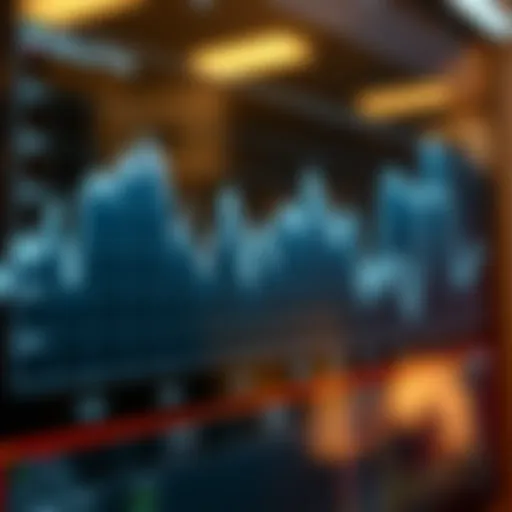High-Paid NFT Art: Trends and Insights for Investors
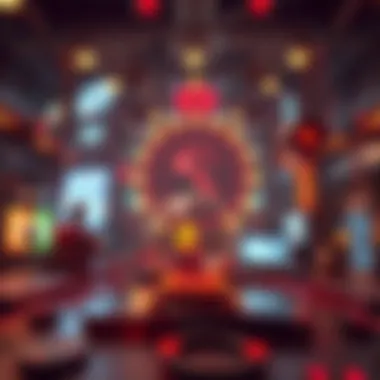
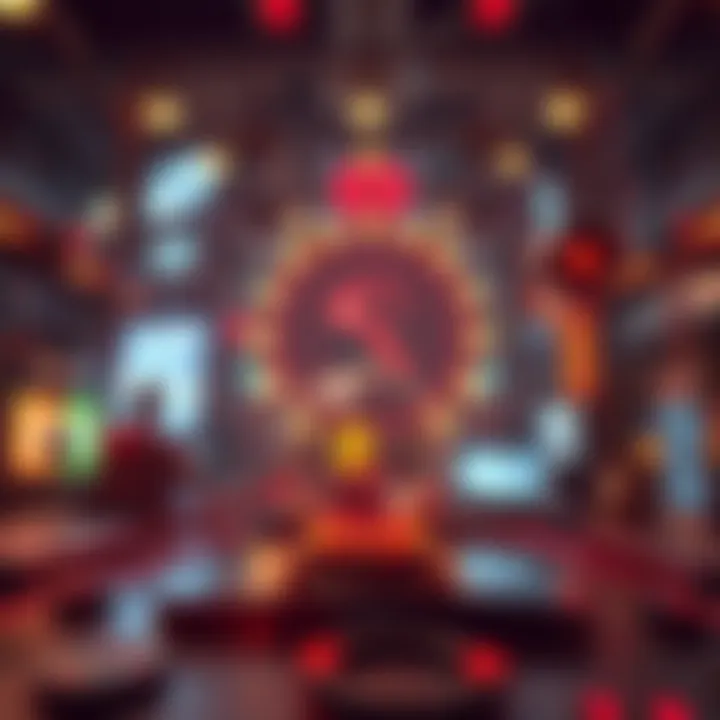
Intro
The digital revolution has reshaped countless industries, but perhaps none are as captivating as the world of art. In recent years, we have witnessed the meteoric rise of high-priced NFT art, engaging seasoned investors and curious novices alike. Unraveling the intricacies behind these digital artworks can be complex, yet it unveils fascinating insights into the intersection of technology, creativity, and economics.
As we delve into this landscape, we will examine various factors that have propelled NFT art into the limelight. What drives the staggering prices at auction? Who are the key players in this transforming market? Moreover, what implications does this phenomenon hold for the future of the traditional art world?
Through a detailed exploration, we will also analyze notable sales, market trends, and the underlying technology that supports the NFT ecosystem. By piecing together these insights, we aim to provide a clearer picture of this innovative domain, offering investors and enthusiasts a comprehensive understanding of the ongoing developments and their potential impacts.
Prologue to NFT Art
The emergence of Non-Fungible Tokens (NFTs) has revolutionized the way we view and engage with art. Unlike traditional pieces that can be physically owned, NFTs represent unique digital assets secured by blockchain technology. This ensures both provenance and authenticity, making them invaluable in today’s digital landscape.
Understanding NFT art is crucial, as it encapsulates a fusion of creativity, technology, and market dynamics. It is not just about the artwork itself but also about the story and history embedded within each token. The intersection of these elements informs its perceived value and significance in the larger art community.
The growing interest and investment in NFT art present both opportunities and challenges. For investors, analysts, developers, and enthusiasts alike, grasping the foundations of NFT art is essential to navigating this complex market. As we delve deeper into this topic, attention will be given to its implications on the traditional art market and the economic landscape as a whole.
Understanding NFTs
NFTs serve as digital certificates of ownership for unique items or content. What sets them apart from other digital assets is their indivisibility and distinctiveness. If you own a typical cryptocurrency, like Bitcoin or Ethereum, every coin is equal and interchangeable. But when it comes to NFTs, each one carries unique information that makes it different from others, regardless of how closely they might appear to be similar.
To elaborate, imagine attending an art gallery and seeing two stunning paintings. Both might be created by the same artist and inspire similar feelings, yet one could carry a far higher price tag due to its provenance or the story behind it. Similarly, an NFT can encapsulate a piece of digital art, music, or even tweets, each regarded with distinct value based on the artist’s reputation, demand in the market, and the narratives that accompany them.
The Evolution of Digital Art
Digital art has journeyed through various phases, from the rudimentary graphic designs created in the late 1960s to the sophisticated multimedia works of today. Initially, artists and creators used digital platforms merely to replicate traditional artistic styles. However, as technology progressed, so did the methods of creation. Nowadays, artists are able to explore new frontiers of creativity through software like Adobe Creative Suite and Procreate, allowing for immersive and interactive artistic expressions.
The introduction of NFTs has marked a significant milestone in the evolution of digital art. It has enabled artists to monetize their work directly and maintain a degree of control over their creations. This direct relationship with buyers eliminates the need for intermediaries, enabling artists to benefit significantly from their work's sales and resale.
In essence, the journey of digital art has been transformative, and with NFTs, it's not only gaining recognition but also financial viability that was often previously elusive. By grasping these developments, one can appreciate the intricacies of high-paid NFT artworks and the broader implications for the art world at large.
"The shift to NFT art is not just a contemporary trend; it’s a fundamental change in how we perceive and value art in society." - Unknown
Understanding these two elements of the NFT landscape creates a solid foundation as we move forward into the realm of high-paid NFT art and its implications.
The Rise of High-Paid NFT Art
The emergence of high-paid NFT art marks a significant shift in both the art world and the realm of digital assets. Understanding this phenomenon is essential for a fair glimpse into how digital artworks command staggering sums at auctions and sales. The intersection of technology and art has paved the way for new possibilities, particularly in investing, collecting, and appreciating art. This trend highlights the growing acceptance of digital mediums as legitimate forms of artistic expression and reflection of societal values.
By examining the evolution of high-value NFT sales, we will uncover how certain pieces transcend traditional market boundaries. Characters involved in this evolving landscape are not only artists but also tech innovators, investors, and collectors. The rise of high-paid NFTs invites inquiry into what influences their value, the implications for both artistic credibility and investment security, and how these forces intertwine with users’ perceptions. From understanding provenance to the role of platform visibility, each element contributes to this remarkable story.
Early Examples of High-Value NFTs
In the early days of NFT art, certain pieces set a precedent for pricing that would eventually ignite a frenzy. One of the first widely recognized high-value NFT sales was that of CryptoKitties, a blockchain-based game that allowed users to breed and trade digital cats. In 2018, a rare CryptoKitty fetched over $170,000, prompting discussions surrounding the monetary potential of digital assets.
Another noteworthy episode came with the sale of Everydays: The First 5000 Days by Beeple in March 2021 for an astonishing $69 million at Christie’s auction. This marked a landmark moment for NFTs, showcasing not just the financial worth of digital art but also validating the entire NFT market.
These instances exemplify how early adopters explored the potential of digital art showcased on blockchain platforms. Beyond individual sales, these pieces also stimulated a growing interest among investors, collectors, and tech-savvy individuals exploring new markets. It's this excitement that laid the groundwork for the robust high-paid NFT sector we see today.
Recent Record Sales
Recent years have seen an explosion of record-breaking NFT art sales that continuously redefine market standards. For example, in December 2021, a piece by Pak named The Merge was sold on Nifty Gateway for approximately $91.8 million, making it one of the highest sales recorded in the NFT space. Such jaw-dropping figures can be attributed to the innovative nature of the artwork that blends technology with artistic creativity.
Another fascinating sale was that of Crossroads, an NFT artwork by Beeple that sold for $6.6 million shortly after the 2020 U.S. presidential election. The piece dynamically changed based on the election results, attracting attention for its interactive storytelling.
This trend of high-profile sales highlights shifting market dynamics where demand drives prices to extraordinary heights, captivating the attention of both seasoned investors and curious enthusiasts alike. As each sale creates waves, it fosters new discussions on authenticity, ownership, and the future trajectory of the NFT art market, making it an exciting time to observe these developments.
Factors Influencing NFT Art Value
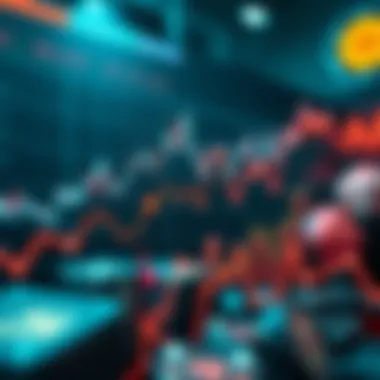
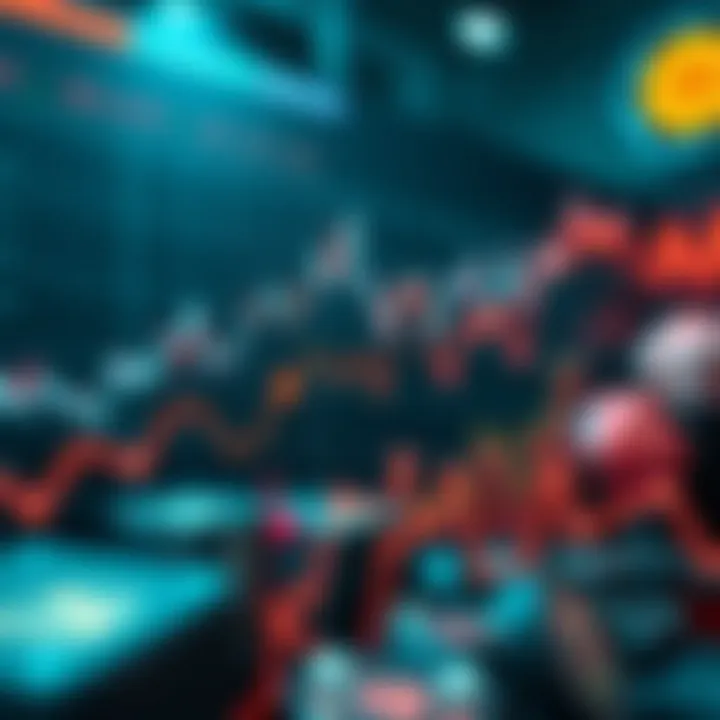
Understanding what drives the value of NFT art is crucial for anyone navigating this dynamic market. From curious investors to seasoned analysts, recognizing these factors can shed light on potential returns and the overall health of the NFT ecosystem. As the old saying goes, "Don’t judge a book by its cover," and the NFT art space is no different. The real value often lies beneath the surface, intricately woven into the tapestry of the digital art landscape.
Provenance and Ownership
The history of an artwork is often as significant as the work itself. In the realm of NFT art, provenance refers to the digital record of ownership that can be traced back to the artist. This aspect of NFTs plays a vital role in determining the value of a piece. The transparency afforded by blockchain technology allows potential buyers to verify the authenticity of an NFT.
When a piece has an illustrious history — perhaps it belongs to a famous collection or was once owned by a notable figure — its value can skyrocket. Collectors are keen on understanding the lineage of their potential purchases, making provenance a top consideration in their buying decisions. The story behind an artwork — who created it, how it was sold, and who has owned it — significantly impacts its perceived worth.
"In the world of NFTs, the tale of ownership can turn a simple piece of art into a digital goldmine."
Artist Reputation and Influence
Just like in traditional art markets, the reputation of the artist attached to an NFT can dramatically sway its value. Emerging artists may start with lower prices, but as they gain recognition, their earlier pieces can appreciate rapidly. A good example here is Beeple, whose NFT sales broke records due to his established prowess in digital art. Market perception of an artist's influence is shaped not only by their resume but also by their involvement in the community, collaborations, and active presence on social media platforms.
The way an artist interacts with their audience and cultivates their brand can propel interest and, subsequently, sales. Notably, now with marketplaces offering tools for increased visibility, artists who engage effectively with their fans can harness demand-driven pricing. Thus, an artist's reputation isn’t just a badge of honor; it’s a currency in itself.
Market Demand and Trends
Lastly, market demand is a living beast that ebbs and flows with trends. Whether it’s a sudden spike in interest for generative art or a new wave of collectors gravitating towards certain genres, it’s vital to keep an ear to the ground. Insights from platforms like Reddit and Twitter often signal shifts in market sentiment. With trends morphing at lightning speed, an NFT that is desirable today might lose favor tomorrow.
The dynamics of demand can also be influenced by external factors, such as economic conditions, social movements, or technological advancements in hardware and platforms that support NFT transactions. Also, seasonal events, launches, or NFT drops spur excitement and potential volatility in pricing.
Being aware of these trends, along with core factors like engagement in digital communities, helps buyers and sellers make well-informed choices.
Through a comprehensive understanding of provenance, artist reputation, and market trends, anyone interested in NFT art can navigate the complexities of this bustling sector with greater fluency.
Top Selling NFT Artworks
The top selling NFT artworks serve as cornerstone examples within the realm of digital art, illustrating the fusion of creativity, technology, and market dynamics. These pieces, often accompanied by staggering price tags, stand out not only for their aesthetic appeal but also as cultural milestones in the evolving landscape of art and commerce. Understanding these artworks provides insight into investor behaviors, market trends, and the potential trajectory of digital creations in a traditionally analog world.
The significance of these top-tier NFTs lies in their ability to showcase the transformation of how art is perceived and valued. Unlike conventional art, where provenance and physical presence often dictate worth, NFT art introduces a new paradigm. Here, value stems from aspects like digital ownership, artist reputation, and community engagement, highlighting the shift in art consumption behaviors. Analyzing these key artworks reveals essential markers of influence and technological advancement that continue to shape the future of art.
"These sales reflect not just financial transactions but a cultural shift in how we define ownership and creativity."
Beeple's Everydays: The First Days
A hallmark in the NFT timeline, Beeple's Everydays: The First 5000 Days represents a monumental leap in the art world. It's an amalgamation of 5,000 individual digital paintings, created over 13 years, culminating in a collage that emerged on the auction block for a staggering $69 million at Christie’s in March 2021. This piece not only captured attention due to its record-breaking sale but also sparked conversations around the validity and value of digital art.
The significance of Beeple’s work extends beyond financial gain; it signifies the potential for artists to accumulate and present their continuous creative journey. In this case, the sold piece encapsulates his evolution and commitment, allegorizing the years of effort and innovation. This highlights a vital trend: collectors are looking for narratives behind the artworks as much as the pieces themselves. Beeple's Everydays became emblematic of a new age for artists navigating the digital realm, challenging traditional concepts of permanence and scarcity.
CryptoPunks and their Cultural Impact
CryptoPunks, created by Larva Labs in 2017, are often hailed as pioneers, establishing a blueprint for NFT art. These unique 10,000 digital avatars showcase a plethora of traits and characteristics that have made them highly sought after among collectors. Their cultural resonance is deeply embedded in the narrative they represent—embodying a subculture that intersects technology, art, and societal trends.
Each CryptoPunk tells a story, acting as a digital identity for their owners. Some collectors express that holding a punk is not just an investment, but a mark of prestige among peers, often recognized in high-society digital conversations. As some of these punks have fetched prices in the millions, their community-driven appeal has created a thriving ecosystem around them. Moreover, the rise of CryptoPunks has influenced numerous copycats and similar projects, further solidifying their position as cultural artifacts in the NFT space.
XCopy's Digital Works
Another influential artist in the NFT space is XCopy, known for merging striking visual styles with compelling themes of decay and capitalism. His works often explore the complexities and contradictions of the digital age, resonating with an audience that appreciates the intersection of pop culture and fine art.
XCopy has masterfully leveraged platforms like SuperRare to showcase and sell his creations, often with pieces achieving high seven-figure sales. His artwork not only emphasizes the visual but is laden with deeper meaning, prompting discussions about the implications of ownership and authorship in a digital format. As such, XCopy stands as a pivotal figure whose contributions help frame the discussion about the value and perceived significance of NFT art in society.
In summary, discussing these top selling artworks enriches our understanding of the NFT landscape, showcasing how digital art moves beyond mere aesthetics to become emblematic of current cultural, economic, and technological paradigms.
Evaluating NFT Art Market Dynamics
Understanding the dynamics of the NFT art market is imperative for stakeholders aiming to navigate this intricate and rapidly shifting landscape. An exploration into existing marketplace platforms and the role of auction houses serves to highlight both the momentum of the NFT sector and the nuances that come with it. This section seeks to delve into these elements, shedding light on how they affect the valuation of digital art, dictate market demand, and influence the trajectory of future developments.


Marketplace Platforms
At the heart of the NFT art world lie the digital marketplaces where these unique assets are bought and sold. Platforms like OpenSea, Rarible, and Foundation have emerged as crucial hubs in the ecosystem. Each has its own set of tools and features that appeal to different types of artists and collectors.
OpenSea is often cited as the biggest marketplace, housing a vast array of NFTs, from art to music to virtual real estate. What sets it apart is its expansive user base, which translates to higher visibility for artists. Meanwhile, Rarible allows for community governance through its own token, enabling fans to engage in decision-making. Finally, Foundation emphasizes a more curated experience, showcasing specific artists and high-quality works.
Evaluating these platforms isn't merely a matter of preference; it's about understanding how fees, user experience, and curation impact sales and artist exposure. Higher fees might deter new creators, while a user-friendly interface can help emerging artists gain traction in an often overwhelming market.
Key Considerations for Artists and Buyers
- User Accessibility: Is the platform easy to navigate, allowing users to quickly find art they love?
- Fees Structure: What percentage does the platform take from each sale? Higher fees can eat into artists' profits.
- Community Engagement: How active is the user base? An engaged audience translates to more potential buyers.
- Curation and Validation: Does the platform validate the quality of art? A curated space can enhance an artist's reputation.
"In the world of NFTs, the platform you choose is half the battle for visibility and sales. Take time to weigh your options."
Auction Houses and NFT Integration
With the rise of NFTs, traditional auction houses have not stood idle. Christie’s made headlines by auctioning off a digital collage by Beeple for a staggering $69 million, signaling to the art world that digital assets deserve the same respect as physical ones. Sotheby’s similarly embraced NFTs, launching dedicated auction events for digital art, thus lowering barriers between the conventional art market and the daring world of NFTs.
Integrating NFTs into auction houses isn’t a mere trend; it suggests a growing acceptance of digital art in mainstream circles. Auction houses lend a sense of legitimacy and gravitas to NFT art, often bringing in seasoned collectors who might be hesitant to explore online marketplaces.
Factors to Consider About Auction Houses:
- Establishment of Trust: Buyers often feel more secure dealing with a well-known auction house compared to a newer platform.
- Curation of High-Quality Art: Houses like Sotheby’s tend to filter works, ensuring that what’s auctioned meets high standards.
- Marketing Power: These houses have substantial networks and marketing prowess, which can significantly boost a piece's visibility.
- Access to a Selective Audience: Well-established collectors and investors frequent these auctions, potentially driving prices up.
The dynamics of the NFT art market continue to evolve, especially with how marketplace platforms and auction houses engage with digital art. As these elements mature, understanding their influence on valuation and market trends will be essential for those invested in or considering entering the NFT landscape.
Impacts of NFT Sales on Traditional Art Market
The intersection of NFT sales and the traditional art market is a multifaceted subject that is capturing the attention of investors and art enthusiasts alike. The rapid ascent of NFTs represents more than just a passing trend; it's reshaping how art is valued, consumed, and perceived within a broader economic context. In recent years, the digital arena has not only begun to blur lines but also to lay bare the idiosyncrasies of our relationship with art, ownership, and what it means to invest in creativity.
Blurring Boundaries between Digital and Traditional
When you peel back the layers, you’ll find that the distinctions between digital assets and traditional art forms are becoming increasingly hazy. Once considered separate realms, artists are now traversing both landscapes, crafting pieces that exist simultaneously in physical and virtual forms.
Take, for example, the work of artists like Mike Winkelmann, famously known as Beeple, whose pieces coexist as NFT drop events while also gracing the walls of prestigious galleries. This fluidity in format creates a unique dialogue between digital file and tangible artwork, challenging the notion of what it means to possess art. The artwork’s essence—its value, emotional weight, and narrative—remains intact, whether it exists on a gallery wall or as a string of characters on the blockchain.
However, this crossover has sparked debates among art purists and tech-savvy investors.
- Art Institutions: Galleries, museums, and art institutions are beginning to adapt their frameworks, recognizing that traditional models of curation must evolve to incorporate the digital wave. Exhibitions now feature both digital screens and physical displays, demonstrating how NFTs expand the scope of artistic expression.
- Collector Mindset: The typical art collector’s mindset is undergoing significant changes. Individuals no longer seek just physical ownership but also digital solvency. The thrill of acquiring a one-of-a-kind NFT can sometimes eclipse the prestige of owning a classical oil painting.
"We are entering an era where digital ownership is no longer seen as lesser but rather as the new frontier of collecting."
Changing Perceptions of Art Ownership
The notion of ownership in art has transformed dramatically with the advent of NFTs, posing both challenges and opportunities in the process. Traditionally, ownership implied a tangible, transferable object, but with NFTs, the spirit of ownership shifts to something more abstract—a digital certificate tied to a work that may exist solely in the virtual space.
Consider how consumers perceive and interact with art today:
- Commodification: The commodification of art through NFTs elevates digital creations to high market values, often challenging conventional thresholds for assessing worth. For example, a meme transformed into an NFT sold for millions, baffling those anchored in traditional valuations.
- Access vs. Ownership: The concept of access also changes. Today’s collectors find themselves grappling with the idea that accessing a piece of digital art isn’t the same as owning it outright.
- Culture of Sharing: We also see the rise of a sharing culture that allows art to be appreciated in new ways—often through social media platforms. The viral spread of a digital piece contributes to its allure but complicates the traditional paradigm of ownership.
As the lines continue to blur, the art world faces a pivotal moment, needing to reconsider old models of engagement and valuation in this emergent digital climate.
This fusion of digital and physical ownership has profound implications not just for art itself but for the entire market cycling through these transformations. The old guard of art is grappling with scrutiny, while the evolving perceptions of who can create and own art are opening the metaphorical floodgates for a diverse array of creators.
As NFT sales continue to unfold, one thing is clear: the dynamics between traditional and digital art are not just shifts but a revolution that is reconfiguring the landscape as we know it.
Challenges Facing NFT Art


The rapid ascent of NFT art has not been without its hurdles. In an era where creative expression meets blockchain technology, several challenges emerge that threaten the very fabric of this innovative market. Understanding these issues is crucial not just for creators but for collectors, investors, and market analysts alike. It offers insight into the sustainability and future viability of this space.
Environmental Concerns
One primary challenge that looms over the NFT art landscape is the environmental impact of blockchain technologies, particularly those that rely on proof-of-work systems like Ethereum. Mining for cryptocurrency, a process integral to verifying transactions, consumes a staggering amount of electric energy.
"NFTs can leave a carbon footprint comparable to that of an entire country." This perspective highlights a critical dilemma. On one hand, NFTs offer artists a new platform for revenue and exposure, yet on the other, they contribute to climate change concerns.
Many artists and buyers are becoming increasingly aware of this dilemma. Some platforms are working tirelessly to mitigate their environmental impact. For instance, transitioning to proof-of-stake models, which are much more energy-efficient, could be a potential solution. Yet, until widespread adoption occurs, the concern remains significant for potential investors or creators who are environmentally conscious.
Possible Solutions:
- Transition to Greener Blockchains: NFT marketplaces like Tezos and Flow are exploring eco-friendly alternatives.
- Carbon Offsetting: Initiatives like planting trees or investing in renewable energy projects could balance out the carbon emissions associated with NFTs.
Legal and Copyright Issues
Another pressing hurdle lies in navigating the complex legal landscape surrounding NFTs. The question of ownership and copyright can often be murky. When someone purchases an NFT, they may assume they possess the rights to reproduce or resell the artwork. However, this belief often doesn't hold true.
In the absence of clear regulatory frameworks, misunderstandings can lead to disputes over intellectual property. Artists face dilemmas over how much they can control their work once it is tokenized. Furthermore, the proliferation of unauthorized replicas raises another layer of complication, whereby individuals mint NFTs from pieces that they do not own legally.
The lack of clarity in copyright legislation regarding digital art and NFTs means creators need to be vigilant. They should consider educating themselves about intellectual property rights, or seek legal counsel to draft contracts that clearly outline the terms of use.
Key Considerations:
- Understand Licensing Agreements: Artists must be explicit in defining what buyers can and cannot do with their NFTs to protect their rights.
- Regulatory Developments: Keeping an eye on evolving laws surrounding digital art and blockchain can help anticipate future challenges.
Both environmental and legal challenges are pivotal in shaping the NFT ecosystem. Continuing discussions and innovations aimed at addressing these concerns will determine how sustainable and accepted the NFT art market will be in the years to come.
Future Trends in High-Paid NFT Art
The future of high-paid NFT art is not just an extension of the present but rather a transformative evolution that combines technology, art, and finance. As the digital landscape continues to shift, so do the methodologies and platforms that enable artists and collectors to interact in this burgeoning market. The emphasis in this section will be on exploring two pivotal aspects: technological advancements and the potential for market expansion. Both elements are crucial in understanding where the market is headed and what new possibilities might arise in this digital-first artistic environment.
Technological Advancements
Technology remains the backbone of the NFT art world, constantly innovating and reshaping the landscape. New tools and platforms emerge regularly, promising to enhance the user experience for artists and collectors alike. For instance, developments in blockchain technology can lead to faster transactions, lower fees, and improved security. This changes the way creators release their work and how buyers interact with it.
With enhanced blockchain interoperability, it’s becoming possible to transfer NFTs across various platforms without losing ownership rights or value. This suggests a more fluid digital art ecosystem, where artists and collectors aren't restricted by a single marketplace.
Moreover, advancements in augmented reality (AR) and virtual reality (VR) present new avenues for experiencing art. Imagine attending an exhibition in the metaverse, where you can view a high-priced piece of art in its full grandeur, interact with it, and even purchase it on the spot. This immersive experience might not only attract traditional art connoisseurs but also a younger, more tech-savvy audience. It's a merging of technology and creativity that could redefine the very essence of how we perceive art.
Potential for Market Expansion
The NFT art market holds vast potential for expansion, moving beyond its current confines into various sectors. One of the most notable areas is the integration with social media platforms. As influencers and creators explore NFTs, they are likely to bring their audiences along for the ride. This could spur increased interest in digital art as fans seek not just to admire the work but to own a piece of it too.
Additionally, the application of NFTs in gaming is gaining traction. Characters, skins, or items in games could be turned into NFTs, offering true ownership to players. These digital assets can be traded or sold, tapping into a multi-billion dollar gaming market. The blurring line between entertainment and investment in this manner could attract a broader audience to NFT art.
Thus, the landscape is fertile for high-paid art. Businesses are beginning to recognize the potential of NFTs as marketing tools—limited edition releases or event-specific NFTs could create buzz and demand, fostering a vibrant marketplace rich in artistic and commercial value.
"The marriage of creativity and technology not only expands the boundaries of art but also redefines economic paradigms in the digital space."
To wrap it all up, while uncertainties loom over the NFT space due to regulatory and environmental concerns, the possibilities for future trends are robust. By anticipating these dynamics, artists, investors, and aficionados can position themselves strategically within the high-paid NFT art market.
Culmination
In summarizing the insights discussed throughout this article, it becomes clear that the realm of high-paid NFT art is not merely a passing trend, but a significant shift in both the art world and the broader financial landscape. A few core elements emerge that highlight just how critical understanding this phenomenon is for anyone involved in the art market–be it investors, artists, or analysts.
First, the economic implications of NFT art cannot be overstated. The staggering prices achieved in recent auctions signify not just a market for digital assets, but a reimagining of art's inherent value. The influx of technology into this space creates new opportunities for monetization, creating an investment avenue that appeals to a generation accustomed to digital transactions.
Furthermore, considerations of technology integration are invaluable. Every transaction forms a part of a blockchain ledger, contributing not only to the artwork's authenticity but also to its future resale value. Understanding this connection is key to navigating the NFT market successfully. Investors informed about the underlying technology will find themselves better equipped to make strategic decisions.
Moreover, the topic sheds light on cultural evolution. As the definitions of creativity and ownership evolve, so too does the conversation surrounding who gets to claim ownership of art in a digital age. This shift is not just about financial gain; it’s about the recognition of diverse forms of artistry and the corresponding value they yield.
From the curation of unique online experiences to the challenge of legal complexities, each point discussed brings forth nuances that intertwine with the contemporary understanding of art. The takeaway is unmistakable: to engage with the NFT space is to engage in a multifaceted dialogue that encompasses art, technology, and society at large.
As we progress into an era where high-paid NFT art continues to gain traction, it’s imperative for stakeholders to remain vigilant and informed. Only by deeply understanding these elements can one hope to navigate the thrilling, albeit unpredictable, world of NFT art.














